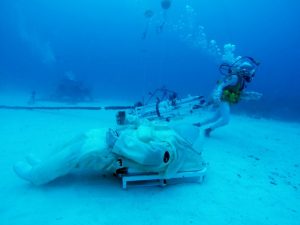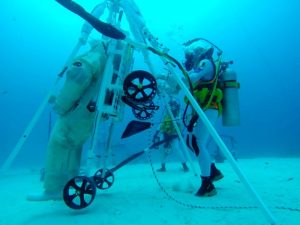
Astronauts response in space. How to test a stretcher on the moon?
The ESA’s Lunar Evacuation System Assembly is designed to rescue astronauts on the moon. Could this stretchers be used also on Mars in the future?
Let us talk about the Lunar Evacuation System Assembly (LESA) to rescue astronauts on the moon and, maybe on other planets. Despite the geological characteristics of the Earth, there is a place where testing a ‘moon stretcher’ in a condition like the one you will face on the moon surface.
The bottom of the ocean floor, with its rocky, sandy terrain and buoyant saltwater, has more in common with the lunar surface than you might imagine. This is why two members of NASA mission NEEMO 23 tested the ESA’s latest prototype to rescue astronauts on the moon.
The “lunar ambulance” is a pyramid-like structure, that enables an astronaut to lift their crewmate onto a mobile stretcher in less than 10 minutes, before carrying them to the safety of a nearby pressurised lander.
The Lunar Evacuation System. Under the sea to the moon! Testing stretcher for response in space

During NASA mission NEEMO 22 in 2017, Pedro Duque, ESA astronaut, and the NASA astronaut Kjell Lindgren tested an earlier prototype. They lived and worked onboard undersea habitat Aquarius for nine days, put LESA to the test.
Hervé Stevenin, ESA head of spacewalk training and Neutral Buoyancy Facility (NBF) operations says that the Lunar Evacuation System is the world’s first prototype for a system that will allow the safe and rapid recovery of a fallen astronaut on the Moon’s surface by a single spacesuit-wearing rescuer. The catalyst for its development came from a three-year Moondive study.
Commissioned by ESA and led by French company Comex, this study looked at how the 10-m deep pool at ESA’s astronaut centre in Cologne, Germany, could be used to simulate lunar gravity underwater to test equipment, tools and operational concepts for the Moon.
A key part of this work was identifying essential activities astronauts would need to perform while carrying out Extravehicular Activities (EVA) on the moon’s surface. Rescuing a fallen crewmate emerged high on the list.
Stevenin declares how important is the skill of astronauts in recognizing a mate in difficulty and have the capability to rescue an incapacitated crewmember on the moon, during lunar exploration.
A stretcher for astronauts response on the moon. What are the advantages and disadvantages?

Hervé explains that they began working on a stretcher for rescue on the moon times ago. They face the importance of providing rescue to an incapacitated crewmember during explorations on the moon. A good understanding of the suit aspect and EVA itself was vital in the development of LESA, as EVA spacesuits are bulky and restrictive. EVA suits are also quite heavy, despite the reduced gravity of the Moon being one-sixth of that on Earth, and pressurised EVA gloves reduce an astronaut’s dexterity.
It is impossible that astronauts could carry a fallen crewmate over their shoulder while wearing an EVA suit. The heaviness of this uniform impedes any kind of extra movement. The objective of ESA was to bring all the rescue actions into the working range of the EVA-suited astronaut to ensure a rapid and safe rescue.
LESA can be transported like a golf caddy and placed close to the fallen astronaut to provide a lifting mechanism and a stretcher that is easy to manoeuvre, as what Herve reports. Once the rescuer has used the device to lift their crewmate and attach the stretcher to their back, they add wheels to the stretcher and transport them to safety.
Next steps for rescue on the moon. Could this stretcher be used also on other planets, like on Mars, in the future?
There has been another evaluation of the second version of LESA during an underwater spacewalk in the Atlantic Ocean. The members of the current nine-day NEEMO 23 mission, ESA astronaut Samantha Cristoforetti and NASA astronaut Jessica Watkins carried it on a pair of weeks ago. The pair wore EVA gloves and take EVA suit constraints into account as they test the lifesaving device.
The pair tested LESA on Comex’s EVA spacesuit simulator. So, rather than taking turns to play the role of a fallen crewmember, the underwater weight of this suit simulator is equivalent to the weight of an astronaut wearing an EVA suit on the Moon.
Their feedback will be useful for further developments of LESA, also as ESA is trying to collaborate with NASA to improve the quality of space missions.
Not only for the moon, maybe. Human expeditions on other planets are on the list. They will, of course, have to be tested and evaluated accurately. This stretcher could represent the first step to develop other ways of response to emergency cases on other space surfaces, like on Mars.
READ ALSO
A stretcher for Daisy: Mountain Rescue team rescued and evacuated a St Bernard on Scafell Pike
What about the ambulance stretcher support?
Stretchers Save Lives


